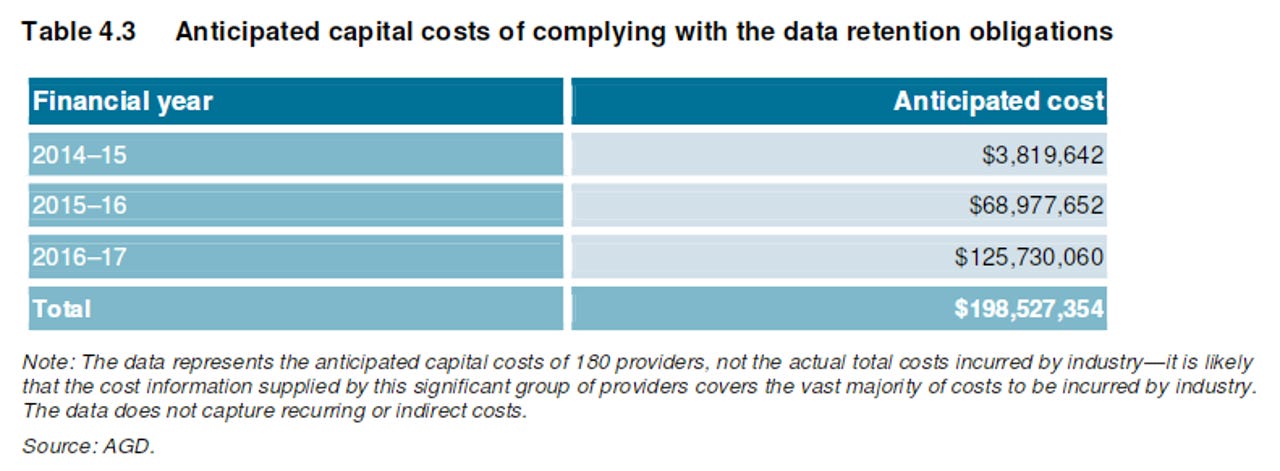Data retention scheme to cost AU$200m in total capital costs by mid-2017: ACMA

The Australian Attorney-General's Department (AGD) has advised that it expects the lifetime capital costs for telcos to comply with data retention obligations to hit the AU$198.5 million mark by the end of the 2016-17 financial year, the Australian Communications and Media Authority (ACMA) said in its Communications report 2015-16 [PDF] tabled in Parliament on Wednesday.

The estimate is based on costs submitted to AGD by Australia's telcos as part of the process to receive a grant to cover some of the costs of the scheme. In September, AGD announced the recipients of its AU$128 million data retention grant pool to be spread among 180 ISPs. Incumbent Australian telco Telstra received the highest amount, at AU$40 million, while the smallest handed over was AU$10,000 to ISP Arris.
The Telecommunications (Interception and Access) Amendment (Data Retention) Act 2015, passed by the Australian Parliament in March, came into effect last October. It mandates that customers' call records, location information, IP addresses, billing information, and other data be stored for two years by telcos, accessible without a warrant by law-enforcement agencies.
Latest Australian news
The ACMA said in its report it would be able to report the actual compliance costs in next year's report, and that no telcos were referred to it for enforcement action.
Elsewhere in the report, the ACMA said that the most popular device to access the internet continues to be the mobile phone, followed by laptops, desktops, tablets, and TVs.
Broken down by age and device most used to access the internet, mobile phones were most used for the 18-34 age bracket, laptops were most used for ages 35-54, while desktops were most used for those beyond 55.
The agency also said the increase in overall data consumption was a result of video content, rather than an increase in the number of users.
"The uptake of [streaming video on demand] services has increased by almost 46 percent in the last year, with the number of Australians paying for subscriptions almost doubling to 32 percent," the ACMA said.
Netflix now reaches a potential audience of 5 million Australians with its 1.9 million subscribers, Stan can potentially reach 891,000 Australians thanks to 332,000 subscriptions, and Presto has 142,000 subscribers. The ACMA said Stan and Presto are growing faster than Netflix thanks to households taking on more than one video streaming service.
The ACMA said 2015-16 saw the first increase in Australia music sales, thanks to music streaming services and the subsequent drop-off in piracy. Of the music services, Spotify holds more than half the market, on 58 percent, followed by Pandora, on 27 percent; Apple Music, with 18 percent; Apple iTunes, on 15 percent; and Google Play holding 9 percent of those surveyed by the ACMA.
In a survey of 1,321 people, the ACMA found 48 percent had a mobile phone data quota of less than 2GB, 35 percent with between 2GB and 6GB of data, and 16 percent with more than 6GB of data.
"The continuing increase in digital data traffic has been the main cause of change in the communications sector over the past year," said acting ACMA Chairman Richard Bean. "Australians downloaded 2.2 million terabytes of data in the quarter to June 2016 alone -- a 114 percent increase on two years ago."
Of the over-the-top communication apps used, the ACMA said 41 percent of all online Australians used Facebook Messenger in the six months to June; 25 percent used Skype; and WhatsApp came third, with 20 percent.